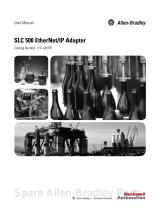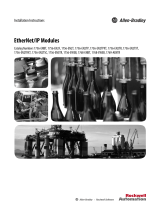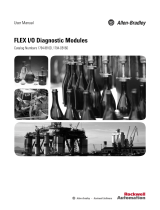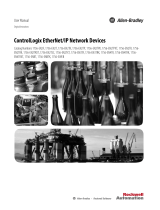Page is loading ...

Publication 1756-IN588A-EN-P - February 2004
Installation Instructions
EtherNet/IP Web Server Module
Catalog Number 1756-EWEB
Use this manual as a guide to install the EtherNet/IP® Web Server Module.
Note that this document covers hardware installation and some configuration
procedures to get you started. Refer to the EtherNet/IP Web Server Module User
Manual, publication number ENET-UM527, for more detailed configuration
information.
The following table lists the contents of this document and where to find
specific information.
Topic See Page
Important User Information 2
Environment and Enclosure 2
Preventing Electrostatic Discharge 4
European Hazardous Location Approval 4
North American Hazardous Location Approval 5
Identify Module Components 8
Prepare the Chassis for Module Installation 9
Determine Module Slot Location 10
Install the Module 11
Using the Web Server Module 19
Troubleshooting the Module 25
Where to Find More Information on Configuring the Module 26
Specifications 27
Rockwell Automation Support 30

2 EtherNet/IP Web Server Module
Publication
1756-IN588A-EN-P - February 2004
Important User Information
Solid state equipment has operational characteristics differing from those of
electromechanical equipment. Safety Guidelines for the Application, Installation and
Maintenance of Solid State Controls (Publication SGI-1.1 available from your local Rockwell
Automation sales office or online at http://www.ab.com/manuals/gi) describes some
important differences between solid state equipment and hard-wired electromechanical
devices. Because of this difference, and also because of the wide variety of uses for solid
state equipment, all persons responsible for applying this equipment must satisfy
themselves that each intended application of this equipment is acceptable.
In no event will Rockwell Automation, Inc. be responsible or liable for indirect or
consequential damages resulting from the use or application of this equipment.
The examples and diagrams in this manual are included solely for illustrative purposes.
Because of the many variables and requirements associated with any particular installation,
Rockwell Automation, Inc. cannot assume responsibility or liability for actual use based on
the examples and diagrams.
No patent liability is assumed by Rockwell Automation, Inc. with respect to use of
information, circuits, equipment, or software described in this manual.
Reproduction of the contents of this manual, in whole or in part, without written permission
of Rockwell Automation, Inc. is prohibited.
Throughout this manual we use notes to make you aware of safety considerations.
WARNING
Identifies information about practices or circumstances that can cause an explosion in a
hazardous environment, which may lead to personal injury or death, property damage, or
economic loss.
IMPORTANT
Identifies information that is critical for successful application and understanding of the
product.
ATTENTION
Identifies information about practices or circumstances that can lead to personal injury or
death, property damage, or economic loss. Attentions help you:
• identify a hazard
• avoid a hazard
• recognize the consequence
SHOCK HAZARD
Labels may be located on or inside the drive to alert people that dangerous voltage may
be present.
BURN HAZARD
Labels may be located on or inside the drive to alert people that surfaces may be
dangerous temperatures.

EtherNet/IP Web Server Module 3
Publication
1756-IN588A-EN-P - February 2004
Environment and Enclosure
This equipment is intended for use in a Pollution Degree 2 industrial
environment, in overvoltage Category II applications (as defined in IEC
publication 60664-1), at altitudes up to 2000 meters without derating.
This equipment is considered Group 1, Class A industrial equipment
according to IEC/CISPR Publication 11. Without appropriate precautions,
there may be potential difficulties ensuring electromagnetic compatibility in
other environments due to conducted as well as radiated disturbance.
This equipment is supplied as "open type" equipment. It must be mounted
within an enclosure that is suitably designed for those specific environmental
conditions that will be present and appropriately designed to prevent personal
injury resulting from accessibility to live parts. The interior of the enclosure
must be accessible only by the use of a tool. Subsequent sections of this
publication may contain additional information regarding specific enclosure
type ratings that are required to comply with certain product safety
certifications.
NOTE: See NEMA Standards publication 250 and IEC publication 60529, as
applicable, for explanations of the degrees of protection provided by different
types of enclosure. Also, see the appropriate sections in this publication, as
well as the Allen-Bradley publication 1770-4.1 ("Industrial Automation Wiring
and Grounding Guidelines"), for additional installation requirements
pertaining to this equipment.

4 EtherNet/IP Web Server Module
Publication
1756-IN588A-EN-P - February 2004
Preventing Electrostatic Discharge
European Hazardous Location Approval
European Zone 2 Certification (The following applies when the product
bears the EEx Marking)
This equipment is intended for use in potentially explosive atmospheres as
defined by European Union Directive 94/9/EC.
The LCIE (Laboratoire Central des Industries Electriques) certifies that this
equipment has been found to comply with the Essential Health and Safety
Requirements relating to the design and construction of Category 3
equipment intended for use in potentially explosive atmospheres, given in
Annex II to this Directive. The examination and test results are recorded in
confidential report No. 28 682 010.
ATTENTION
This equipment is sensitive to electrostatic discharge,
which can cause internal damage and affect normal
operation. Follow these guidelines when you handle this
equipment:
• Touch a grounded object to discharge potential
static.
• Wear an approved grounding wriststrap.
• Do not touch connectors or pins on component
boards.
• Do not touch circuit components inside the
equipment.
• If available, use a static-safe work station.
• When not in use, store the equipment in
appropriate static-safe packaging.

EtherNet/IP Web Server Module 5
Publication
1756-IN588A-EN-P - February 2004
Compliance with the Essential Health and Safety Requirements has been
assured by compliance with EN 50021.
North American Hazardous Location Approval
The following information applies when operating this equipment in
hazardous locations:
Products marked "CL I, DIV 2, GP A, B, C, D" are suitable for use in Class I
Division 2 Groups A, B, C, D, Hazardous Locations and nonhazardous
locations only. Each product is supplied with markings on the rating
nameplate indicating the hazardous location temperature code. When
combining products within a system, the most adverse temperature code
(lowest "T" number) may be used to help determine the overall temperature
code of the system. Combinations of equipment in your system are subject to
IMPORTANT
When using this equipment, consider the following:
• This equipment is not resistant to sunlight or other
sources of UV radiation.
• The secondary of a current transformer shall not be
open-circuited when applied in Class I, Zone 2
environments.
• Equipment of lesser Enclosure Type Rating must be
installed in an enclosure providing at least IP54
protection when applied in Class I, Zone 2
environments.
• This equipment shall be used within its specified
ratings defined by Allen-Bradley.
• Provision shall be made to prevent the rated voltage
from being exceeded by transient disturbances of
more than 40% when applied in Class I, Zone 2
environments.

6 EtherNet/IP Web Server Module
Publication
1756-IN588A-EN-P - February 2004
investigation by the local Authority Having Jurisdiction at the time of
installation.
Informations sur l’utilisation de cet équipement en environnements
dangereux:
Les produits marqués "CL I, DIV 2, GP A, B, C, D" ne conviennent qu'à une
utilisation en environnements de Classe I Division 2 Groupes A, B, C, D
dangereux et non dangereux. Chaque produit est livré avec des marquages sur
sa plaque d'identification qui indiquent le code de température pour les
environnements dangereux. Lorsque plusieurs produits sont combinés dans
un système, le code de température le plus défavorable (code de température
le plus faible) peut être utilisé pour déterminer le code de température global
WARNING
EXPLOSION HAZARD
• Do not disconnect equipment unless power has
been removed or the area is known to be
nonhazardous.
• Do not disconnect connections to this equipment
unless power has been removed or the area is
known to be nonhazardous. Secure any external
connections that mate to this equipment by using
screws, sliding latches, threaded connectors, or
other means provided with this product.
• Substitution of components may impair suitability
for Class I, Division 2.
• If this product contains batteries, they must only be
changed in an area known to be nonhazardous.

EtherNet/IP Web Server Module 7
Publication
1756-IN588A-EN-P - February 2004
du système. Les combinaisons d'équipements dans le système sont sujettes à
inspection par les autorités locales qualifiées au moment de l'installation.
AVERTISSEMENT
RISQUE D’EXPLOSION
• Couper le courant ou s’assurer que
l’environnement est classé non dangereux
avant de débrancher l’équipement.
• Couper le courant ou s’assurer que
l’environnement est classé non dangereux
avant de débrancher les connecteurs. Fixer
tous les connecteurs externes reliés à cet
équipement à l’aide de vis, loquets
coulissants, connecteurs filetés ou autres
moyens fournis avec ce produit.
• La substitution de composants peut rendre cet
équipement inadapté à une utilisation en
environnement de Classe I, Division 2.
• S’assurer que l’environnement est classé non
dangereux avant de changer les piles.

8 EtherNet/IP Web Server Module
Publication
1756-IN588A-EN-P - February 2004
Identify Module Components
Use the following figure to identify the external features of the 1756-EWEB
module.
LINK NET OK
31272-M
Backplane
Connector
Front View
Front
Panel
Side View
Bottom View
Front
of
Module
RJ45 Cable
Connector located
on underside of module
Backplane
Connector
Web +
MAC ID Label (may be inside here or
at bottom as shown below)
MAC ID Label (may be inside here
or at top as shown above)

EtherNet/IP Web Server Module 9
Publication
1756-IN588A-EN-P - February 2004
Prepare the Chassis for Module Installation
Before you install the module, you must install and connect a ControlLogix
TM
chassis and power supply.
For information on installing these products, refer to the publications listed in
the following table.
Chassis
Type
Chassis
Installation
Power
Supply
Power Supply
Installation
Series B: 1756-A4, -A7, -A10, -A13 Pub. No.
1756-IN080
1756-PA72/B Pub. No.
1756-5.67
1756-PB72/B
1756-PA75/A Pub. No.
1756-5.78
1756-PB75/A
20805
-
M
1756-A4
Chassis
Power
Supply

10 EtherNet/IP Web Server Module
Publication
1756-IN588A-EN-P - February 2004
Determine Module Slot Location
You can install the module in any slot in the ControlLogix chassis. You can
also install multiple 1756-EWEB modules in the same chassis. The figure
below shows chassis slot numbering in a 4-slot chassis. Slot 0 is the first slot
and is always the left-most slot in the rack (the first slot to the right of the
power supply)
.
WARNING
When you insert or remove the module while
backplane power is on, an electrical arc can occur. This
could cause an explosion in hazardous location
installations.
Be sure that power is removed or the area is
nonhazardous before proceeding. Repeated electrical
arcing causes excessive wear to contacts on both the
module and its mating connector. Worn contacts may
create electrical resistance that can affect module
operation.
Power Supply
Slot 0
Slot 1
Slot 2
Slot 3
Chassis

EtherNet/IP Web Server Module 11
Publication
1756-IN588A-EN-P - February 2004
Install the Module
31275-M
31276-M
Align the circuit board with top and
bottom guides in the chassis.
1
Slide the module into the chassis. Make sure the
module backplane connector properly connects to
the chassis backplane.
2
The module is properly installed when
it is flush with the power supply or other
installed modules.
Circuit Board
3

12 EtherNet/IP Web Server Module
Publication
1756-IN588A-EN-P - February 2004
Removing or Replacing the Module (when applicable)
IMPORTANT
If you are replacing an existing module with an identical
one, and you want to resume identical system operation,
you must install the new module in the same slot.
31277-M
31278-M
Push on upper and lower module tabs
to disengage them.
1
Slide module out of chassis.
2

EtherNet/IP Web Server Module 13
Publication
1756-IN588A-EN-P - February 2004
Installing or Removing the Module Under Power
This module is designed to be installed or removed while chassis power is
applied.
Wire the EtherNet/IP Connector
Use an RJ45 connector to connect to the EtherNet/IP network. Wire the
connector according to the following illustration:
For detailed EtherNet/IP connection information, see the EtherNet/IP Media
Planning and Installation Guide, publication number ENET-IN001.
WARNING
When you insert or remove the module while backplane
power is on, an electrical arc can occur. This could cause
an explosion in hazardous location installations.
Be sure that power is removed or the area is
nonhazardous before proceeding. Repeated electrical
arcing causes excessive wear to contacts on both the
module and its mating connector. Worn contacts may
create electrical resistance that can affect module
operation.
RJ 45
8
1
8 ------ NC
7 ------ NC
6 ------ RD-
5 ------ NC
4 ------ NC
3 ------ RD+
2 ------ TD-
1 ------ TD+

14 EtherNet/IP Web Server Module
Publication
1756-IN588A-EN-P - February 2004
Connect the Module to the EtherNet/IP Network
Attach the RJ45 connector to the EtherNet/IP port on the bottom of the
module as shown below:
WARNING
If you connect or disconnect the communications
cable with power applied to this module or any device
on the network, an electrical arc can occur. This could
cause an explosion in hazardous location installations.
This is the bottom, back of the module that
connects into the chassis.
RJ-45 EtherNet/IP
connector
Connect the cable
here.

EtherNet/IP Web Server Module 15
Publication
1756-IN588A-EN-P - February 2004
Apply Chassis Power
IMPORTANT
We recommend connecting the module to the
network via a 100MB EtherNet/IP switch, which will
reduce collisions and lost packets and increase
network bandwidth. For detailed EtherNet/IP
connection information, see the following
publications:
• EtherNet/IP Performance and Application Guide,
publication ENET-AP001
• EtherNet/IP Media Planning and Installation Guide,
publication ENET-IN001
31280-M

16 EtherNet/IP Web Server Module
Publication
1756-IN588A-EN-P - February 2004
Check Power Supply and Module Status
Check the LED indicators and alphanumeric display to determine if the
power supply and module are operating properly.
The alphanumeric display should cycle through the following states: “TEST -
PASS - OK - REV x.x,” where “x.x” is the module’s firmware revision. The
display then alternates between “OK” and the module’s EtherNet/IP address.
31281-M
LINK NET OK
OK indicator is
Power Supply
indicator is GREEN.
LINK
NET
red during self-test,
then green.
Alphanumeric
Display
Web +

EtherNet/IP Web Server Module 17
Publication
1756-IN588A-EN-P - February 2004
Obtain an IP Address
By default, the web server module is DHCP enabled. If you connect the web
server module to a network that has a DHCP server, that server will assign a
dynamic IP address to the web server module and the four-digit display on the
front of the web server module will display each of the four numbers of the IP
address.
If your network does not have a DHCP server, use one of the methods
described in chapter
2 of the EtherNet/IP Web Server Module User Manual,
publication ENET-UM527 to assign an IP address to the web server module.
Access the Home Page of the Module
From your web browser, enter the IP address of the web server module. The
module displays its Home page
.
Specify the IP address of
the web server module in
the Address window of your
web browser.
This is the module’s
home page..

18 EtherNet/IP Web Server Module
Publication
1756-IN588A-EN-P - February 2004
Log Into the Module
Many of the features of the web server module require you to log in with
appropriate access. If you select a feature, such as New Data View, the web
server module prompts you to enter your user name and password. The
default user name is “Administrator” with no password (leave the Password
field blank).
You can set up as many as 25 user accounts. Each account can have read, read
and write, or administrator access. For more information, see the EtherNet/IP
Web Server Module User Manual, publication ENET-UM527.
Default Access:
User Name: Administrator
(not case sensitive)
Password:
(leave blank, no password)

EtherNet/IP Web Server Module 19
Publication
1756-IN588A-EN-P - February 2004
Confirm the Network Configuration
On the Administrator Settings → Device Configuration → Network
Configuration page, you can verify the IP address and other network settings.
For more information, see the EtherNet/IP Web Server Module User Manual,
publication ENET-UM527.
Using the Web Server Module
To help familiarize yourself with the web server module, some of the tasks
you can accomplish include:
• Create a data view
• Configure email
• Configure the time server
• Enable/disable other services
These tasks are described in the following section.

20 EtherNet/IP Web Server Module
Publication
1756-IN588A-EN-P - February 2004
Create a Data View
Before you can create a data view in the web server, the tags you want to view
must exist in the controller that is local (in the same chassis) to the web server
module. The tags in the controller must be controller-scoped. For example,
create:
TEST
type DINT
controller-scope
value 123
To create a create a data view, you need Administrator or Write access. You
create a data view from the Data Views → New Data View page.
1. In the Create Data View window, specify a name for the data view and
enter a description (optional).
2. In the New Data View window, specify at least one tag (EWEB_test
in this example). You must specify the:
• slot number of the controller
• tag name (exactly as it is in the controller)
• type of tag
• how to display the tag data
• access limit of the data view
/








